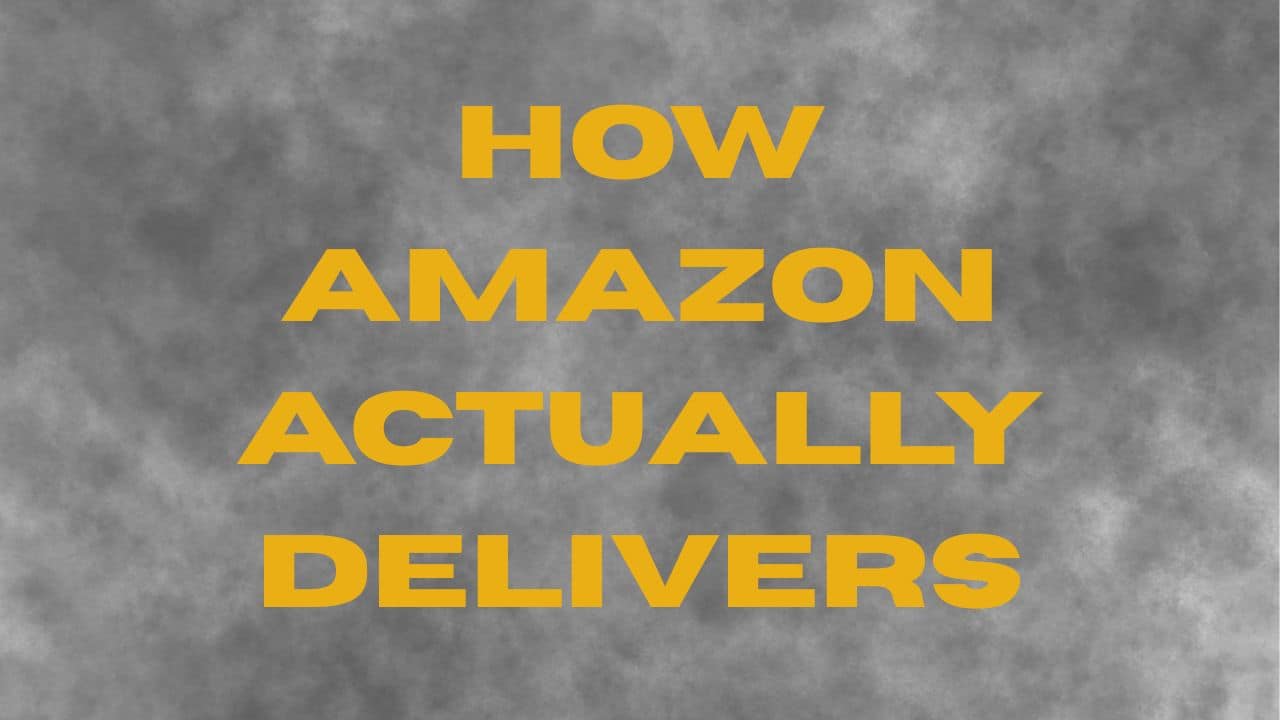If you’ve ever ordered something from Amazon at 10pm and had it show up on your porch the next afternoon for basically nothing, you’ve probably had the same thought everyone else does:
“How is that even possible?”
It’s easy to assume it’s just volume and money. But Amazon’s speed and cost advantage isn’t just about size. It’s about orchestration, how they’ve fused supply chain design, warehouse operations, robotics, data, and AI into one machine.
In this post, I’ll walk through how that machine works end to end, what’s actually happening behind the “Buy Now” button, and a few takeaways you can apply even if you’re not Amazon.
Table of Contents
ToggleThe Scale Behind the Promise
Let’s start with how big we’re talking.
Take one of Amazon’s fulfillment centers. The facility I’m referencing here is near Denver, Colorado. It’s close to a million square feet. It’s multi-level. It holds hundreds of thousands of unique products, everything from batteries to pet food to printer cables, all staged for same-day or next-day delivery in that local area.
Now zoom out:
- There are thousands of these facilities globally.
- Amazon ships tens of millions of packages per day.
- They have hundreds of thousands of drivers out on the road.
- And they’re running over a million warehouse robots across their network.
That combination, physical footprint, workforce, and automation at scale, is the backbone. But it’s not the secret. The secret is how they decide what goes where, when, and how fast it moves.
Let’s break down how it actually works.
Step 1: Predicting What You’ll Want Before You Want It
Fast delivery starts long before you place an order. It starts with an inventory strategy.
For delivery to happen in one day (or a few hours in some markets), the product has to already be sitting in the facility near you. That means Amazon has to answer a hard question:
What do people in Denver (or Dallas, or Berlin) want to buy this week?
That’s where AI comes in.
Amazon uses predictive models to forecast demand at the regional level. That includes seasonal swings, local buying behavior, historical trends, promotions, and even weather. The goal is to make sure the Denver site is stocked with the “right” hundreds of thousands of items, not just random bulk inventory.
That is the first big lesson for any organization: you don’t win on speed when the order comes in. You win on anticipation.
Step 2: Getting Product Into the Building, and Back Out Again
Once Amazon knows what it needs, product starts flowing into the building.
Here’s where the process gets interesting.
Cross-docking
In a traditional warehouse, inbound product gets received, checked, and stored somewhere on a shelf until it’s ordered.
Amazon does that when needed, but they also use something called cross-docking. That means when a truck pulls up with inbound goods, certain items never actually get “put away.” They move directly from the inbound trailer onto an outgoing delivery vehicle.
Think about how powerful that is:
- No storage.
- No double handling.
- Near-zero time spent sitting idle.
That’s part of how you get next-day or same-day delivery without carrying insane local safety stock.
Chaotic storage
For inventory that does need to sit in the building, Amazon uses what’s called “chaotic storage.”
Don’t let the name throw you. “Chaotic” does not mean “disorganized.” It means “optimized by machine instead of human intuition.”
In an old-school warehouse, every SKU (stock keeping unit) has a defined bin location. It’s tidy on paper, but rigid in practice.
In Amazon’s world, the system decides in real time where to put a pallet, a case, or even a single unit. The item doesn’t go to “its” shelf. It goes to the closest available physical slot that makes sense based on:
- how fast it’s expected to move,
- how often it’s ordered,
- and how efficiently a robot can retrieve it later.
Humans would struggle to manage that kind of fluid layout. Robots don’t.
This is the second big lesson: stop assuming “organized” means “static.” Dynamic placement, driven by software, beats fixed slotting in high-volume environments.
Step 3: You Click “Buy Now”
Now let’s talk about the part you see: you go to Amazon.com and hit order.
From that moment, a few things happen almost immediately:
- Your order is routed to the nearest fulfillment center that already has that product in stock.
- The system queues a pick request.
- Robots get to work.
Those robots are not just props for PR. They’re core. They retrieve the pod or bin with your item and bring it to a human (or, increasingly, another automated station) for picking.
This matters for two reasons:
- People aren’t spending their shifts walking miles of aisles. The work comes to them.
- Throughput is predictable and trackable. Every movement is timestamped and measured.
As soon as your items are picked, AI steps in again, this time to design your box.
Yes, even the packaging step is optimized. The system calculates the smallest possible container that will protect the items while taking up minimal space in the delivery vehicle. That matters because less air in the box = more boxes per route = lower cost.
Step 4: Load, Route, Deliver
Once packed, the order is staged for delivery. This is where the “last mile” operation takes over.
Here’s what’s happening behind the scenes:
- Routes are optimized automatically based on location density, traffic, road network, and time windows.
- Drivers don’t just get an address list. They get a sequence, turn by turn, designed to minimize total time per stop and total miles per shift.
- The system even considers seemingly tiny things, like which side of the street you should be on so you’re not crossing traffic back and forth with a package in your hands.
That level of control is why Amazon can hit same-day windows while keeping cost per delivery relatively low.
And they’re relentless about performance:
Drivers are held to strict delivery targets. Vans are monitored and maintained based on usage patterns and predictive wear. The logistics chain is instrumented all the way down to the route, not just the truck.
This is the third lesson: the last mile is not an afterthought. It is a designed product.
Step 5: Humans and Robots, and Who’s Doing the Work
One thing that makes Amazon different is how aggressively it uses automation, where it creates speed, not just cost savings.
A few things to call out:
- Amazon uses well over a million robots in fulfillment operations today.
- Robotics in picking, storage, and movement is not a “future roadmap,” it’s the current operating model.
- Amazon even acquired the robotics provider (originally Kiva Systems) that built much of this tech. That tells you how strategic they view this layer.
Over time, that ratio of robots to humans keeps shifting. Not because people “don’t matter,” but because predictability, repeatability, and speed are easier to scale mechanically than manually.
Here’s the key point for other organizations:
Automation isn’t just about replacing labor. It’s about reshaping labor around higher-value decision points, and letting machines handle repetitive motion, travel time, and micro-optimizations.
So What Can the Rest of Us Learn?
Most businesses are not going to build an Amazon-scale fulfillment network. And that’s fine. You don’t need thousands of facilities and a million robots to take some real lessons from this model.
Here are the patterns worth paying attention to:
- Forecasting drives everything.
Amazon doesn’t wait for demand, then react. It predicts demand by location and stages inventory accordingly. If you’re constantly firefighting stock-outs or overstock, this is the place to focus. - Speed comes from eliminating touches.
Cross-docking is basically “don’t store what you can ship.” You don’t need robotics to apply that thinking. You just need a tighter inbound-to-outbound handoff. - Let software drive layout.
Chaotic storage works because you stop trying to keep the warehouse “logical” for humans and instead keep it efficient for the system. Most companies are still doing the opposite. - Last mile is a product, not a cost center.
Route planning, packaging, and capacity planning are part of the experience you sell to the customer. If delivery is slow, unpredictable, or expensive, the market will feel it. - Automation is not all-or-nothing.
You don’t need to “go full robot.” But you should be asking: Where do humans still waste time walking, searching, or re-entering data that a machine could surface instantly?
Bringing It Back to Your Supply Chain
Here’s the part where a lot of executives get stuck:
“We’re not Amazon.”
That’s true. But that’s not the bar.
The bar is: Are you making intentional design decisions around inventory, fulfillment, and last mile, or are you letting your old process shape your future?
Because Amazon’s real advantage isn’t just money, automation, or headcount. It’s that their operating model is designed around the promise they make to the customer.
If you can tighten even one of the loops above, demand prediction, inbound handling, warehouse flow, routing, you don’t just lower cost. You get faster, more reliable, and harder to displace.
And that’s the real game.
If you’re looking at your own supply chain and thinking, “We’re nowhere near that level of predictability or control,” that’s normal. We work with organizations every day who are in exactly that spot, legacy processes, high manual effort, over-reliance on “tribal knowledge,” and a ton of pressure to ship faster.
That’s fixable.
If you want to talk through where your biggest unlock actually is, forecasting, warehouse flow, fulfillment, routing, or tech stack, reach out. This is what we do.






